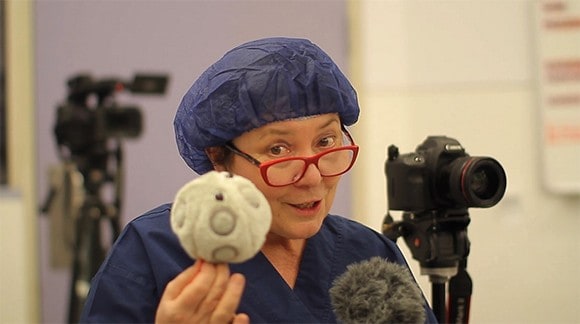
edited by Melissa Sweet, Croakey, 4 August 2020
Five priority areas to improve the treatment and lives of people with head and neck cancers are highlighted in a unique new video series, reports journalist and cancer survivor Julie McCrossin.
The videos also share the stories and questions of survivors, and “tell the blunt truth about how the Australian and New Zealand health systems are failing to meet the life-long needs of the survivors of this dreadful group of cancers”.
Julie McCrossin writes:
On World Head Neck Cancer Day, 27 July 2020, a unique series of 14 videos on innovations in the treatment of head and neck cancer patients was launched on multiple social media platforms. The final five videos in the series will be released this week.
The focus of each video is on the clinical practice of multidisciplinary team members and researchers to improve survival and quality of life. The videos are designed to give the latest evidence-based information to patients, family members and clinicians through interviews with people on the frontline of healthcare.
The interviews are filmed in the workplace. We meet a surgeon, nurse and speech pathologist in an operating theatre beside a surgical robot. We meet a radiation oncologist, dietician and another speech pathologist in a bunker beside a LINAC, the machine that delivers radiation therapy. We meet a special needs dentist and ENT nurse in a dental surgery. The medical oncologists and researchers, who explain the latest developments in chemotherapy and immunotherapy, are at the cancer centre where they work.
We discuss managing distress and psychological recovery with a psycho-oncology social worker, a clinical psychologist, a specialist nurse and two senior researchers. We meet a medical physicist who leads a team developing an alternative to the rigid plastic mask that is currently used to bolt a patient down during radiation treatment to the head.
The project is unique in its scale and content. But most significantly, it is unique in the editorial independence given to a head and neck cancer patient to interview clinical experts, share the stories and questions of fellow survivors, and produce videos that tell the blunt truth about how the Australian and New Zealand health systems are failing to meet the life-long needs of the survivors of this dreadful group of cancers.
The Head and Neck Cancer 2020 Video Series is hosted by St Vincent’s Hospital Sydney, The Kinghorn Cancer Centre and St Vincent’s Private Hospital Sydney.
Two doctors who made this series possible are: Associate Professor Richard Gallagher, an ENT surgeon who is the Director of Cancer Services and the Head and Neck Service at the St Vincent’s Health Network Sydney and a radiation oncologist, and Associate Professor Dion Forstner who works with GenesisCare at St Vincent’s Clinic and Macquarie Hospital in Sydney and who is a director of the Australasian head and neck cancer charity, BeyondFive.

Survival and recovery
The patient given the opportunity to make this series with editorial independence is myself, Julie McCrossin a former broadcaster and presenter with ABC Radio National, ABC TV and Network Ten.
In 2013 I was treated for stage four, HPV-related oropharyngeal cancer in my tonsils, tongue and throat. (HPV is the Human Papillomavirus). My treatment was 30 sessions of radiation therapy with weekly chemotherapy. I lost over 20kgs in six weeks due to the impact of the radiation on my capacity to swallow.
I lost the ability to speak for a couple of months. I worked with a speech pathologist for a year to return my voice to normal.
My survival and recovery was made possible by the care of my wife, Melissa, our children and a network of staunch friends. I don’t say this to be nice. The evidence tells us that head and neck cancer patients with social support have a better chance of survival.
In 2019, just over 5,200 Australians were diagnosed with a head and neck cancer. Of these, just over 3,800 were men and 1,400 were women.
Aboriginal and Torres Strait Islander people are disproportionately affected, with 1,280 Indigenous people diagnosed last year. The five-year survival rate is 71 percent for non-Indigenous people and 42 percent for Indigenous people (Australian Institute for Health and Welfare).
Throughout treatment and recovery, head and neck cancer patients need a large multidisciplinary team of nurses, allied health, doctors and a dentist. The reason there are so many videos in the series is that it takes a big mob of clinicians to treat us and keep us alive.
The treatments for head and neck cancers are widely acknowledged to be among the toughest in the cancer community. Those of us who survive have life-long side effects that increase with severity over time.
It was an absolute privilege to make these videos and give a voice to the experience of these patients and family members who so rarely get any attention anywhere.
The lack of coverage in the media and the limited research in this field means patients not only get the terrible shock of a cancer diagnosis, but they also struggle to find accurate, easy-to-understand information. We would be lost without the Cancer Councils, the charity BeyondFive and a limited number of peer support groups.
It was also a pleasure in this series to give a voice to the dedicated clinicians who struggle themselves to obtain the funding and resources they need to help their patients, especially after the immediate period of acute treatment.
What needs to be done?
Here are priority areas that are crying out for action.
- We need to close the 30 percent gap in survival rates for Aboriginal and Torres Strait Islander people. It’s bloody shocking. I urge you to watch the interview with Head and Neck ENT surgeon and Worimi man, Associate Professor Kelvin Kong from Newcastle on the video, ‘Aboriginal & Torres Strait Islander Patients, Family and Community’. We discuss what we need to do. Most importantly, we need a network of Aboriginal and Torres Strait Islander specialist nurses to co-ordinate care, travel and communication and we need mainstream services for diagnosis, support and follow-up to work closely with Aboriginal-controlled health services.
- We need multidisciplinary teams to provide pre-treatment clinics and education and long-term follow and support beyond five years when the side effects of treatment intensify.
- We need a national network of specialist head and neck cancer nurses, as we have for breast and prostate cancer patients. While our numbers are smaller, our short and long-term needs are complex and our quality of life is too often distressingly poor.
- We need access to Medicare-funded dental care. Many patients have multiple extractions prior to treatment. Radiation causes dry mouth which severely damages our teeth and it gets worse with time. The surgical impacts can be severe on the mouth as well. Many patients can only eat soft food or be tube fed for the rest of their lives due to dental trauma. On behalf of my fellow patients, many of whom cannot afford dental care, I say, “Help!”
- We need a community and a GP awareness campaign on the symptoms of head and neck cancer so we get referred to an ENT surgeon for assessment before we are stage four. This is urgent as oropharyngeal cancer caused by HPV or the Human Papillomavirus is now an epidemic in western countries.
More people are now diagnosed with HPV-related throat cancer in the US than cervical cancer. HPV is transmitted by oral sex. Most people eliminate the virus with their immune system. But an unlucky minority do not.
Watch the video on Innovations in Surgery with Associate Professor Richard Gallagher to hear all about it. You will also hear about Trans Oral Robotic Surgery or TORS and see a robot. It is shameful that public patients who are eligible for this far-less invasive surgery to the throat have very limited access in Australia and New Zealand because most of the robots are in private hospitals.
Finally, thank you to filmmaker Daniel Taylor who has brought style and creative visual imagery to these videos. Daniel’s family is affected by cancer and he has given his whole heart to this project. Thank you also to web man Ricky Onsman for building a head and neck cancer resource to link patients, family & multidisciplinary teams to information and each other.
For more information
See the videos on: https://www.youtube.com/channel/UCQUQxIbK3tGP4j4JP-EKQHQ
Visit: https://headneckcancerforum.com/
On Facebook: https://www.facebook.com/headandneckcanceraustralia
More about Julie McCrossin.
Originally published: https://croakey.org/improving-the-care-of-people-with-head-and-neck-cancer-new-video-series/
